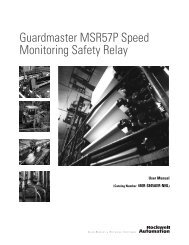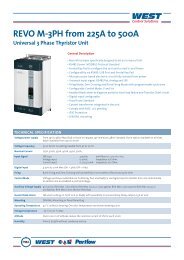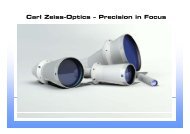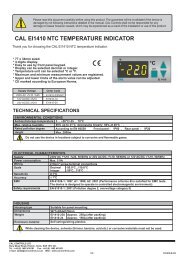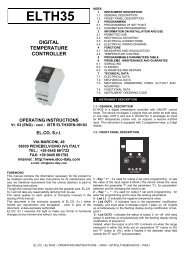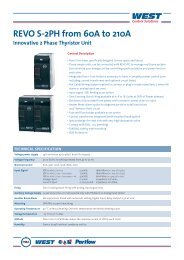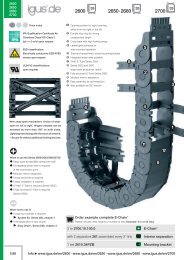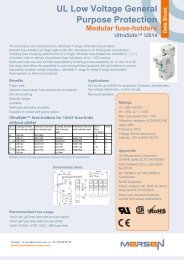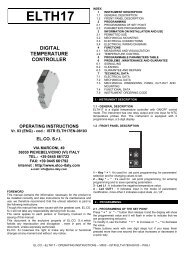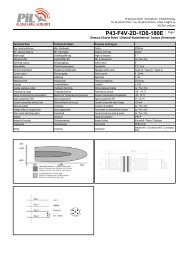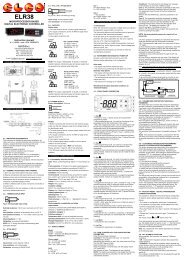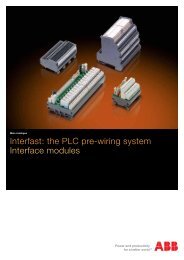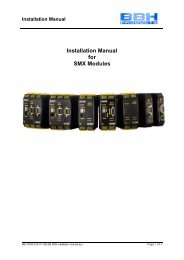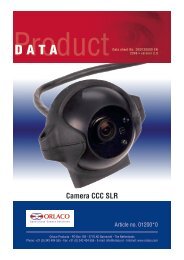Next Generation: GSR Guardmaster Safety Relays - OEM Automatic ...
Next Generation: GSR Guardmaster Safety Relays - OEM Automatic ...
Next Generation: GSR Guardmaster Safety Relays - OEM Automatic ...
You also want an ePaper? Increase the reach of your titles
YUMPU automatically turns print PDFs into web optimized ePapers that Google loves.
<strong>Safety</strong> Applications and Wiring Diagrams<br />
Interlock Switch - Multiple Gate Access<br />
Trojan T15, Elf-GD2, 800F, CI, 100S<br />
+24V DC<br />
Trojan T15-GD2<br />
440K-T11397<br />
11 12<br />
21 22<br />
ELF-GD2<br />
440K-E33046<br />
11 12<br />
21 22<br />
E-stop<br />
800FM-<br />
MT44MX02V<br />
S11 S12<br />
Start<br />
800FM-<br />
F3MX10<br />
Stop<br />
800FM-<br />
E4MX01<br />
A1 S34 13<br />
23<br />
K1<br />
K2<br />
33 41<br />
Machine control system<br />
can replace this circuit<br />
arrangement.<br />
K1<br />
L1 L2 L3<br />
24V DC Com<br />
Input<br />
1756-IB16<br />
1769-IQ16<br />
1746-IB16<br />
1734-IB4<br />
1793-IB6<br />
PLC<br />
Processor<br />
Output<br />
1756-OW16I<br />
1769-OW8<br />
1746-OW4<br />
1734-OW2<br />
1793-OW4<br />
RESET 0<br />
CI<br />
AM<br />
440R-S13R2<br />
MM<br />
S21 S22 A2 L11 Y32 14<br />
24<br />
34 42<br />
K1 K2 100S-<br />
C43DJ22BC<br />
Circuit Status<br />
Circuit shown with the safety gates closed and e-stop released. The safety relay is de-energized. The motor is off. The monitoring circuit is<br />
connected to S34 for automatic reset of the CI relay.<br />
Operating Principle<br />
With 2NC + 1NO interlocks, a potential exists for the gate to be slightly open which results in the auxiliary contact being closed and the safety<br />
being open. The machine cannot start and the PLC does not know which gate is open. By sending the second safety channel through the PLC,<br />
the machine control system knows which door is open, when the safety system is off due to a gate that may be slightly open. The infinite<br />
simultaneity feature of safety relays like the CI allow enough time for the PLC to process all the gates and close the second channel of the safety<br />
relay without creating a lockout condition.<br />
When a safety gate is opened, the interlock opens Ch1 directly to the safety relay and opens Ch2 which is connected to the input of a PLC. The<br />
PLC must then open Ch2 of the safety relay. The logic in the PLC must open the Ch2 signal if any one or more of the safety gates are open and<br />
must only close the Ch2 circuit when all of the safety gates and e-stop are closed. The PLC can also use the information on the inputs on<br />
PanelView or similar device. The auxiliary signal (Y32) from the CI must be an input to the PLC. This PLC program must only close its output when<br />
all the safety inputs are closed and the auxiliary signal from the CI is closed. This allows the PLC to indirectly confirm that its own output is<br />
working properly.<br />
STARTING: Channel 1 input (S11/S12) of the SI is satisfied. Using isolated relay contacts in its output module, the PLC closes the second safety<br />
channel (21/22 of the SI). The safety outputs of the SI close. Press the Start button to start the motor.<br />
STOPPING: Opening any one of the safety gates or pressing the e-stop causes the motor to turn off. Closing the gate or releasing the e-stop does<br />
not cause the motor to start due to the start-stop interlocking circuit. To restart the motor, close the safety gate or release the e-stop. Then press<br />
the start button.<br />
Fault Detection<br />
If the PLC fails with its output closed, the safety relay will detect the difference between the safety gate and the PLC and stop the motor. A single<br />
fault (open or short) across one of the interlocks will be detected by the safety relay and the motor will be turned off. The motor will remain off<br />
until the fault is corrected or power is cycled. If either contactor K1 or K2 sticks ON - the motor will stop on command due to the other contactor,<br />
but the SI cannot be reset (thus the fault is revealed to the operator). A single fault detected on the SI input circuits will result in the lock-out of<br />
the system to a safe state (OFF) at the next operation of the safety gate or e-stop device. Contactors K1 and K2 are controlled by the safety<br />
system. Contactor K2 is controlled by both the machine control system and the safety system. This increases the probability of performance of<br />
the safety function because K1 is significantly less likely to weld at the same time as K2 due to the diversity of expected wear out times.<br />
Ratings<br />
The safety function initiated by the Trojan T15 and ELF-GD2 safety gate interlocks and the 800F e-stop meets the safety performance<br />
requirements of SIL CL2 per IEC 62061:2005 and has a Category 3 structure that can be used in systems requiring Performance Levels up to PLd<br />
per ISO13849-1:2008. This circuit executes a Category 0 stop.<br />
K2<br />
M<br />
- 14 -<br />
R



